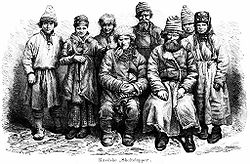Skolts
Säʹmmla Nuõrttsääʹm | |
|---|---|
 Drawing of Russian Skolt Sami from 1871 | |
| Total population | |
| c. 1,250 | |
| Regions with significant populations | |
| 500[1]–700[2] | |
| |
The Skolt Sámi or Skolts are a
Lutheran Christians
like most Sami and Finns.
History

As a result of the
Treaty of Tartu (1920), the Skolt homeland was split in two: the western part, Petsamo, became part of Finland and the eastern part became part of the Soviet Union. The border became a threat to the identity of the Skolts as it grew difficult for them to live as they traditionally had with reindeer husbandry, hunting and fishing as the source of their livelihood. Many Finnish immigrants moved back to their traditional Skolt homeland. In 1926, one-quarter of Petsamo's population were Skolts, and in 1930 the proportion dropped to one-sixth.[6]
After the
Rybachiy Peninsula to the Soviet Union and after the Continuation War (1941–1944), it lost Petsamo, too. As a result, the Skolts living in Suonikylä and Paatsjoki were evacuated to Finland, with the Suonikylä Skolts settling in Sevettijärvi, the Paatsjoki Skolts in Keväjärvi and along the Rautujoki River of Sevettijärvi, and the Petsamo Skolts in the villages of Mustola, and Sarmijärvi in Nellim
.
Demographics
Current estimates put the number of ethnic Skolt Sámi at around 1250, of whom approximately 400 can speak
Skolt Sámi
. Most of them live in Finland today.
In Finland, Russia and Norway they number about 700, 400 and possibly more than 150.[7]
Religion

Saint Tryphon of Pechenga converted the Skolts to Christianity in the 16th century and even today, the majority of Skolts are members of the Eastern Orthodox Church.

References
- ^ a b Ethnologue report for language code: sms
- ^ "Skolt Sámi on Siida's website". Archived from the original on 2007-10-23. Retrieved 2010-04-01.
- ^ a b Østsamisk museum, Neiden
- PMID 35675367.
- ^ Rantanen, Timo, Vesakoski, Outi, Ylikoski, Jussi, & Tolvanen, Harri. (2021). Geographical database of the Uralic languages (v1.0) [Data set]. Zenodo. https://doi.org/10.5281/zenodo.4784188
- ^ Tuija Saarinen Seppo Suhonen: Koltat, karjalaiset ja setukaiset, Snellman-Instituutti 1995
- ^ Walton, Stephen J. (2012-07-14). "Skoltesamar". Klassekampen. p. 3.
Dei fleste bur i Finland, der gruppa tel om lag sjuhundre personar. I Noreg bur det vel 150 skoltesamar, og i Russland kanskje litt fleire.
